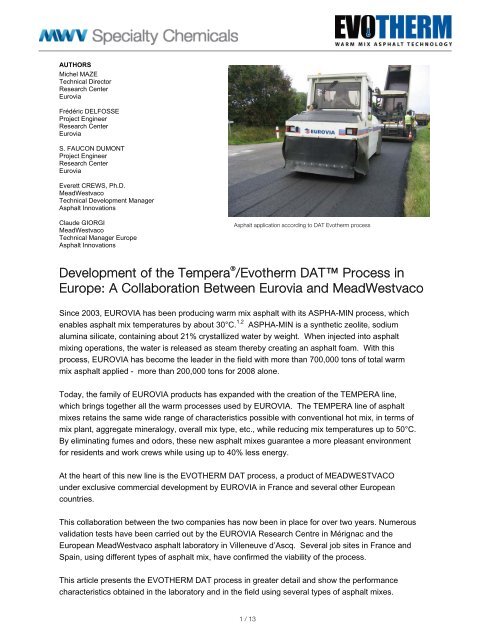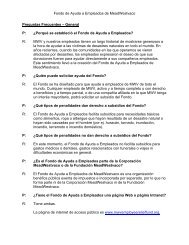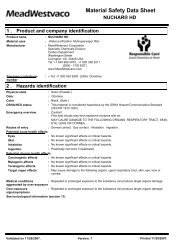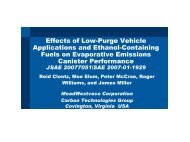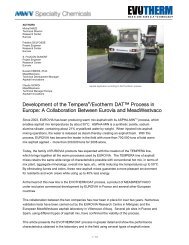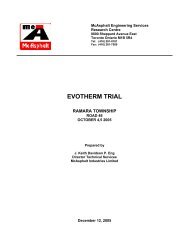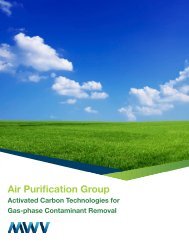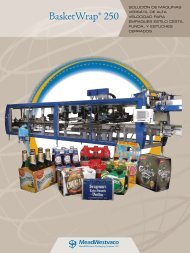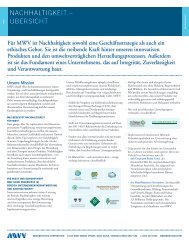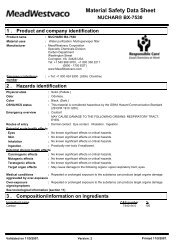Development of the Tempera®/Evotherm DAT ... - MeadWestvaco
Development of the Tempera®/Evotherm DAT ... - MeadWestvaco
Development of the Tempera®/Evotherm DAT ... - MeadWestvaco
You also want an ePaper? Increase the reach of your titles
YUMPU automatically turns print PDFs into web optimized ePapers that Google loves.
AUTHORS<br />
Michel MAZE<br />
Technical Director<br />
Research Center<br />
Eurovia<br />
Frédéric DELFOSSE<br />
Project Engineer<br />
Research Center<br />
Eurovia<br />
S. FAUCON DUMONT<br />
Project Engineer<br />
Research Center<br />
Eurovia<br />
Everett CREWS, Ph.D.<br />
<strong>MeadWestvaco</strong><br />
Technical <strong>Development</strong> Manager<br />
Asphalt Innovations<br />
Claude GIORGI<br />
<strong>MeadWestvaco</strong><br />
Technical Manager Europe<br />
Asphalt Innovations<br />
Asphalt application according to <strong>DAT</strong> Evo<strong>the</strong>rm process<br />
<strong>Development</strong> <strong>of</strong> <strong>the</strong> Tempera ®<br />
/Evo<strong>the</strong>rm <strong>DAT</strong> Process in<br />
Europe: A Collaboration Between Eurovia and <strong>MeadWestvaco</strong><br />
Since 2003, EUROVIA has been producing warm mix asphalt with its ASPHA-MIN process, which<br />
enables asphalt mix temperatures by about 30°C. 1,2 ASPHA-MIN is a syn<strong>the</strong>tic zeolite, sodium<br />
alumina silicate, containing about 21% crystallized water by weight. When injected into asphalt<br />
mixing operations, <strong>the</strong> water is released as steam <strong>the</strong>reby creating an asphalt foam. With this<br />
process, EUROVIA has become <strong>the</strong> leader in <strong>the</strong> field with more than 700,000 tons <strong>of</strong> total warm<br />
mix asphalt applied - more than 200,000 tons for 2008 alone.<br />
Today, <strong>the</strong> family <strong>of</strong> EUROVIA products has expanded with <strong>the</strong> creation <strong>of</strong> <strong>the</strong> TEMPERA line,<br />
which brings toge<strong>the</strong>r all <strong>the</strong> warm processes used by EUROVIA. The TEMPERA line <strong>of</strong> asphalt<br />
mixes retains <strong>the</strong> same wide range <strong>of</strong> characteristics possible with conventional hot mix, in terms <strong>of</strong><br />
mix plant, aggregate mineralogy, overall mix type, etc., while reducing mix temperatures up to 50°C.<br />
By eliminating fumes and odors, <strong>the</strong>se new asphalt mixes guarantee a more pleasant environment<br />
for residents and work crews while using up to 40% less energy.<br />
At <strong>the</strong> heart <strong>of</strong> this new line is <strong>the</strong> EVOTHERM <strong>DAT</strong> process, a product <strong>of</strong> MEADWESTVACO<br />
under exclusive commercial development by EUROVIA in France and several o<strong>the</strong>r European<br />
countries.<br />
This collaboration between <strong>the</strong> two companies has now been in place for over two years. Numerous<br />
validation tests have been carried out by <strong>the</strong> EUROVIA Research Centre in Mérignac and <strong>the</strong><br />
European <strong>MeadWestvaco</strong> asphalt laboratory in Villeneuve d’Ascq. Several job sites in France and<br />
Spain, using different types <strong>of</strong> asphalt mix, have confirmed <strong>the</strong> viability <strong>of</strong> <strong>the</strong> process.<br />
This article presents <strong>the</strong> EVOTHERM <strong>DAT</strong> process in greater detail and show <strong>the</strong> performance<br />
characteristics obtained in <strong>the</strong> laboratory and in <strong>the</strong> field using several types <strong>of</strong> asphalt mixes.<br />
1 / 13
EVOTHERM OVERVIEW<br />
History<br />
EVOTHERM is a process developed by Asphalt Innovations , a MEADWESTVACO business.<br />
The first patents and project sites date from <strong>the</strong> end <strong>of</strong> 2003. 3,4 A world leader in <strong>the</strong> field <strong>of</strong><br />
surfactants and additives for asphalt emulsions, MEADWESTVACO quite naturally developed<br />
its first generation <strong>of</strong> warm mix asphalt (EVOTHERM ET) based on <strong>the</strong> use <strong>of</strong> asphalt<br />
emulsions. The project binder was first converted into a high-residue asphalt emulsion (70%<br />
binder residue) in an emulsion plant, and <strong>the</strong>n this emulsion was injected in place <strong>of</strong> liquid<br />
binder at <strong>the</strong> mix plant. The water and MEADWESTVACO warm mix additives present in <strong>the</strong><br />
emulsion enabled <strong>the</strong> company to manufacture asphalt mixes 100°F below conventional hot mix<br />
while guaranteeing mix properties and pavement performance.<br />
Since 2005, various studies and evaluations have been carried out (mainly in <strong>the</strong> USA) by a<br />
wide range <strong>of</strong> universities, transportation agencies, and o<strong>the</strong>r research organizations, which<br />
have demonstrated <strong>the</strong> outstanding performances <strong>of</strong> EVOTHERM mixtures compared with <strong>the</strong>ir<br />
hot mixes equivalents. 5,6, 7 One example is <strong>the</strong> experiment conducted at NCAT (<strong>the</strong> National<br />
Center for Asphalt Technology) in Auburn (AL, USA) where two sections <strong>of</strong> EVOTHERM<br />
pavement (sections numbered E9 and E10) constructed on <strong>the</strong> NCAT Pavement Test Track<br />
have been in place since 2005. After being subjected to more than 10 million equivalent singleaxle<br />
loads (ESAL’s), <strong>the</strong> rutting measured was less than 3 mm on <strong>the</strong> two test sections. 8<br />
Always concerned with optimizing <strong>the</strong> cost and performance <strong>of</strong> its products, MEADWESTVACO<br />
subsequently patented <strong>the</strong> EVOTHERM <strong>DAT</strong> process (Dispersed Asphalt Technology) in 2006<br />
and <strong>the</strong> first job was undertaken in <strong>the</strong> state <strong>of</strong> Texas in February 2007 and in France in July<br />
2007.<br />
The core concept behind EVOTHERM <strong>DAT</strong> is to start with <strong>the</strong> same additives and concentrate<br />
<strong>the</strong>m in an aqueous phase. This aqueous phase is <strong>the</strong>n injected directly into <strong>the</strong> asphalt line<br />
(5% w/w asphalt) when <strong>the</strong> materials are coated. This does away with <strong>the</strong> cost <strong>of</strong> processing<br />
and transporting <strong>the</strong> emulsion, reducing fur<strong>the</strong>r <strong>the</strong> environmental impact <strong>of</strong> <strong>the</strong> EVOTHERM<br />
process.<br />
Perfecting this direct injection process allowed <strong>the</strong> EVOTHERM process to move aggressively<br />
to full-scale projects, with more than 150 jobs completed during 2008 throughout <strong>the</strong> world (USA,<br />
Canada, Mexico, China and Europe) for a total <strong>of</strong> more than 400,000 tons <strong>of</strong> mix.<br />
2 / 13
EVOTHERM <strong>DAT</strong><br />
Thus, EVOTHERM <strong>DAT</strong> is a warm mix asphalt production procedure relying on <strong>the</strong> use <strong>of</strong> an<br />
aqueous solution <strong>of</strong> additive. The EVOTHERM <strong>DAT</strong> provides <strong>the</strong> mix with <strong>the</strong> rheological<br />
properties needed during production and construction, while ultimately improving adhesion<br />
between <strong>the</strong> binder and aggregate.<br />
An aqueous solution with between 10 to 15% in weight <strong>of</strong> additive (e.g., EVOTHERM E1) is<br />
produced <strong>the</strong>n adjusted to pH 2.0 +/- 0.3. [O<strong>the</strong>r EVOTHERM <strong>DAT</strong> products do not require pH<br />
adjustment.] This solution is <strong>the</strong>n injected directly into <strong>the</strong> asphalt line at a rate <strong>of</strong> between 5 to<br />
10% w/w asphalt. [The solution also may be injected directly into a pug mill <strong>of</strong> a batch plant.]<br />
In this way, <strong>the</strong> coating plant does not require any modification, except for a branch connection<br />
fitted to <strong>the</strong> asphalt line and <strong>the</strong> addition <strong>of</strong> a pump (and a flow meter) to regulate <strong>the</strong><br />
EVOTHERM additive injection.<br />
Photo 1: Metering kit<br />
Photo 2: Staking on bitumen line<br />
3 / 13
THE BENEFITS REALIZED:<br />
The benefits in temperature reduction realized with <strong>the</strong> EVOTHERM <strong>DAT</strong> technology are on <strong>the</strong><br />
order <strong>of</strong> 50 to 60°C compared to <strong>the</strong> reference hot mixes. Thus, <strong>the</strong> various construction<br />
projects completed with this process [and discussed herein] used mix produced between 105°C<br />
and 120°C depending on <strong>the</strong> aggregate materials, <strong>the</strong> grade <strong>of</strong> asphalt, and <strong>the</strong> type <strong>of</strong> asphalt<br />
mixes produced.<br />
The first obvious benefit is <strong>the</strong> reduction in <strong>the</strong> consumption <strong>of</strong> energy when manufacturing <strong>the</strong><br />
asphalt mixes, as <strong>the</strong> job materials need to be heated less than when manufacturing <strong>the</strong><br />
conventional hot mix. Various job sites have shown a savings <strong>of</strong> around 40% in energy, with<br />
measured gains from 35% to 55% depending on <strong>the</strong> moisture content <strong>of</strong> <strong>the</strong> aggregate<br />
materials and <strong>the</strong> ambient wea<strong>the</strong>r conditions.<br />
The second direct consequence <strong>of</strong> this reduction in temperature is a significant drop in <strong>the</strong><br />
emission rates <strong>of</strong> stack gases and particulates at <strong>the</strong> mix plant. Measurements highlighted <strong>the</strong><br />
following levels:<br />
- 48% reduction in greenhouses gases<br />
- 58% reduction in nitrogen oxides,<br />
- 41% reduction in sulphur dioxide, which is responsible for acid rain.<br />
Finally, <strong>the</strong> work <strong>of</strong> <strong>the</strong> paving crew has become much less difficult, since <strong>the</strong> warm mixes are<br />
generally compacted at between 80°C and 110°C, compared to 120°C to 140°C for <strong>the</strong> hot mix.<br />
Also, <strong>the</strong> drop in nuisance odors makes working in an urban environment or a confined<br />
environment (underground parking, tunnels, etc.) much easier.<br />
LABORATORY STUDIES OF VARIOUS TYPES OF MIX<br />
The close collaboration between <strong>the</strong> two enterprises, Eurovia and <strong>MeadWestvaco</strong>, made it easy<br />
to execute <strong>the</strong> first laboratory validation <strong>of</strong> <strong>the</strong> properties and performance characteristics <strong>of</strong> <strong>the</strong><br />
Evo<strong>the</strong>rm warm mix asphalt process. Described below are some examples <strong>of</strong> typical results.<br />
TWO BBSG 0/10 DENSE WEARING COURSE MIX FORMULATIONS WITH AGGREGATE<br />
MATERIALS FROM MAZIERES AND DONIA AND GENOUILLAC QUARRIES (DIORITES)<br />
The EUROVIA Study and Research Centre, based in Mérignac, carried out two, level III<br />
formulation studies for each formula <strong>of</strong> BBSG 0/10 used, in each case comparing <strong>the</strong><br />
EVOTHERM mixture with its hot mix reference.<br />
The EVOTHERM mixtures were manufactured at 110°C and <strong>the</strong> specimens for <strong>the</strong> various tests<br />
were compacted at 100°C. The hot reference bituminous mixes were manufactured and<br />
compacted at 160°C.<br />
The aggregate gradation curves <strong>of</strong> <strong>the</strong> mixtures conformed to <strong>the</strong> European Norm NF EN<br />
13108-1.<br />
4 / 13
In both cases, <strong>the</strong> bitumen content is 5.8 % total.<br />
The different results <strong>of</strong> <strong>the</strong> formulation studies for each <strong>of</strong> <strong>the</strong> bituminous mixes are summarized<br />
in Tables 1 and 2.<br />
TABLE 1<br />
Properties <strong>of</strong> 0/10 Semigranular Asphalt Mix Using Mazières Quarry Aggregate<br />
Test<br />
BBSG 0/10 Mazières<br />
Hot Mix Control EVOTHERM <strong>DAT</strong><br />
5 / 13<br />
Specifications<br />
(NF EN 13108-1)<br />
PCG (NF EN 12697-31)<br />
V10 16.3 16.9<br />
V60 9.7 9.7 5-10<br />
Duriez (NF EN 12697-12)<br />
% Air Voids 7.6 6.8<br />
Compressive Strength dry, Cd (MPa) 11,700 12,400<br />
Compressive Strength wet, Cw (MPa) 10,000 9800<br />
I/C = 100* Cd/Cw 86 79 > 75<br />
ITSR (NF EN 12697-12)<br />
Indirect Tensile Strength, air (kPa) 1356 1063<br />
Indirect Tensile Strength, wet (kPa) 1091 860<br />
ITSR, Tensile Strength Ratio 80.5 80.9 > 70<br />
Rutting (NF EN 12697-12)<br />
% at 30,000 cycles 5.5 3.9 < 7.5 (class 2)<br />
% Air Voids 6.9 8 5 – 8<br />
Modulus (NF EN 12697-26)<br />
% Air Voids 7.9 7.8 5 – 8<br />
Modulus at 15°C, 10 Hz (MPa) 13,298 14,232 >7,000<br />
TABLE 2<br />
Properties <strong>of</strong> 0/10 Semigranular Asphalt Mix Using Donia-Genouillac Quarry Aggregate<br />
BBSG 0/10 Donia-Genouillac<br />
Hot Mix Control EVOTHERM <strong>DAT</strong> Specifications<br />
Test<br />
PCG (NF EN 12697-31)<br />
(NF EN 13108-1)<br />
V10 16.2 15.1<br />
V60<br />
Duriez (NF EN 12697-12)<br />
9 7.5 5-10<br />
% Air Voids 8.8 6.7<br />
Compressive Strength dry, Cd (MPa) 12,600 11,700<br />
Compressive Strength wet, Cw (MPa) 9900 9200<br />
I/C = 100* Cd/Cw<br />
ITSR (NF EN 12697-12)<br />
78.5 78 > 75<br />
Indirect Tensile Strength, air (kPa) 1478 1186<br />
Indirect Tensile Strength, wet (kPa) 1154 842<br />
ITSR, Tensile Strength Ratio<br />
Rutting (NF EN 12697-12)<br />
78.1 71.0 > 70<br />
% at 30,000 cycles 4.7 5.5 < 7.5 (class 2)<br />
% Air Voids<br />
Modulus (NF EN 12697-26)<br />
6.9 6.2 5 – 8
These results show <strong>the</strong> outstanding behavior <strong>of</strong> <strong>the</strong> EVOTHERM mixtures compared to <strong>the</strong>ir hot<br />
mix references. With <strong>the</strong>se two mixes, <strong>the</strong> use <strong>of</strong> EVOTHERM <strong>DAT</strong> enables <strong>the</strong> warm mix<br />
asphalt to exhibit identical performance characteristics as <strong>the</strong> hot mix control.<br />
STUDY OF A BBSG MIX USING RAP<br />
To illustrate <strong>the</strong> performance possibilities enabled by <strong>the</strong> Evo<strong>the</strong>rm <strong>DAT</strong> technology, ano<strong>the</strong>r<br />
study was undertaken using RAP materials. Conserving natural resources and preserving <strong>the</strong><br />
environment has compelled Eurovia more and more to use recycled asphalt pavement (RAP)<br />
materials in <strong>the</strong>ir asphalt mixes. The development <strong>of</strong> warm asphalt techniques will realize its<br />
true potential only if performance demonstrated with RAP mixes (containing up to 30% RAP).<br />
The research center <strong>of</strong> Eurovia tested <strong>the</strong> performance properties <strong>of</strong> a BBSG 0/10 containing<br />
Thiviers virgin aggregate plus 30% RAP. The combined aggregate and RAP materials<br />
formulation conformed with <strong>the</strong> European standard NF EN 13108-1. The binder utilized was a<br />
traditional asphalt with pen 35/50 dosed at a total <strong>of</strong> 5.7% by weight <strong>of</strong> mix.<br />
The hot mix controls were made and compacted at 160°C, while <strong>the</strong> Evo<strong>the</strong>rm warm mixes<br />
were produced at 110°C and compacted at 100°C.<br />
Table 3 shows <strong>the</strong> properties <strong>of</strong> <strong>the</strong> mixes obtained in this study.<br />
All <strong>the</strong> properties <strong>of</strong> <strong>the</strong> mixes conformed to <strong>the</strong> norm NF EN 13108-1. Moreover, one will<br />
notice that despite <strong>the</strong> marked differences in production temperatures <strong>of</strong> <strong>the</strong> warm and hot<br />
mixes, <strong>the</strong> workability and <strong>the</strong> mechanical properties <strong>of</strong> <strong>the</strong> mixes were nearly identical.<br />
The Duriez test for moisture resistance also met <strong>the</strong> specifications <strong>of</strong> <strong>the</strong> norm, which is<br />
remarkable when one considers <strong>the</strong> temperature reduction and <strong>the</strong> use <strong>of</strong> 30% RAP.<br />
These performance results (with <strong>the</strong> Thiviers aggregate and 30% RAP) highlight <strong>the</strong> important<br />
contribution <strong>of</strong> <strong>the</strong> EVOTHERM additives with regard to two key points: warm mix<br />
compactability (workability) and warm mix moisture resistance. Two o<strong>the</strong>r key characteristics<br />
(rut resistance and strength) point directly to <strong>the</strong> sound intrinsic properties <strong>of</strong> <strong>the</strong> materials.<br />
6 / 13
TABLE 3<br />
Properties <strong>of</strong> 0/10 Semigranular Asphalt Mix Using Thiviers Quarry Aggregate with 30% RAP<br />
BBSG 0/10 Thiviers + 30% RAP<br />
Hot Mix Control EVOTHERM <strong>DAT</strong> Specifications<br />
Test<br />
PCG (NF EN 12697-31)<br />
(NF EN 13108-1)<br />
V10 14.7 15.1<br />
V60<br />
Duriez (NF EN 12697-12)<br />
7.8 8.3 5-10<br />
% Air Voids 7.3 6.4<br />
Compressive Strength dry, Cd (MPa) 13,600 12,700<br />
Compressive Strength wet, Cw (MPa) 11,000 9800<br />
I/C = 100* Cd/Cw<br />
ITSR (NF EN 12697-12)<br />
80 77 > 75<br />
Indirect Tensile Strength, air (kPa) 1513 1387<br />
Indirect Tensile Strength, wet (kPa) 1278 1054<br />
ITSR, Tensile Strength Ratio<br />
Rutting (NF EN 12697-12)<br />
84.5 76.0 > 70<br />
% at 30,000 cycles 4.3 4.8 < 7.5 (classe 2)<br />
% Air Voids<br />
Modulus (NF EN 12697-26)<br />
6.3 7.2 5 – 8<br />
% Air Voids 6.7 6.3 5 – 8<br />
Modulus at 15°C, 10 Hz (MPa) 13,567 13,872 >7,000<br />
FORMULATION OF A BITUMEN 0/14 SAND-GRAVEL TYPE III MIX (GB)<br />
Ano<strong>the</strong>r case study shows <strong>the</strong> formulation and performance properties <strong>of</strong> an Evo<strong>the</strong>rm mixture<br />
based on a bitumen sand-gravel mix (GB) <strong>of</strong> type III.<br />
As in <strong>the</strong> preceding examples, a level III study was conducted by <strong>the</strong> Eurovia Research Center.<br />
The composition and formulation <strong>of</strong> <strong>the</strong> mixes conformed to European norm NF EN 13108-1.<br />
The binder was a conventional 35/50 penetration asphalt, dosed at 4.5% by weight <strong>of</strong> mix.<br />
The hot mix control was produced and compacted at 160°C, while <strong>the</strong> EVOTHERM mix was<br />
produced at 110°C and compacted at 100°C.<br />
Table 4 shows that <strong>the</strong> properties <strong>of</strong> <strong>the</strong> both mixes conformed to <strong>the</strong> specification <strong>of</strong> NF EN<br />
13108-1.<br />
Moreover, <strong>the</strong> above three examples demonstrate and validates <strong>the</strong> performance capabilities <strong>of</strong><br />
EVOTHERM with a variety <strong>of</strong> different mix types. Regardless <strong>of</strong> <strong>the</strong> mix type studies, <strong>the</strong><br />
aggregate mineralogy utilized, or o<strong>the</strong>r material properties, <strong>the</strong> warm mix formulas conformed to<br />
all specifications <strong>of</strong> <strong>the</strong> hot mix controls.<br />
In order to validate <strong>the</strong> above laboratory results, two projects were conducted in 2007. This<br />
article presents results obtained from two different field formulations, each containing RAP. For<br />
each <strong>of</strong> <strong>the</strong> two projects, a program <strong>of</strong> study was developed that involved analysis <strong>of</strong> field cores<br />
to determine in place performance.<br />
7 / 13
TABLE 4<br />
Properties <strong>of</strong> 0/14 Roadbase Asphalt Mix Using Thiviers Quarry Aggregate<br />
GB 0/14 cl III Thiviers<br />
Hot Mix Control EVOTHERM <strong>DAT</strong><br />
Test<br />
8 / 13<br />
Specifications<br />
(NF EN 13108-1)<br />
PCG (NF EN 12697-31)<br />
V10 15.3 14.7 >14<br />
V60 6.4 5.8 75<br />
ITSR (NF EN 12697-12)<br />
Indirect Tensile Strength, air (kPa) 1950 1978<br />
Indirect Tensile Strength, wet (kPa) 1520 1464<br />
ITSR, Tensile Strength Ratio 78 74 > 70<br />
Rutting (NF EN 12697-12)<br />
% at 30,000 cycles 4.5 5.5 < 10<br />
% Air Voids 8 7.5 7 – 10<br />
Modulus (NF EN 12697-26)<br />
% Air Voids 5.2 5.7 5 – 8<br />
Modulus at 15°C, 10 Hz (MPa) 15,900 15,200 >9,000<br />
FIELD PROJECTS USING EVOTHERM <strong>DAT</strong><br />
Using <strong>the</strong> EVOTHERM <strong>DAT</strong> process, 800 tons <strong>of</strong> mix were produced and placed in June 2008.<br />
The mix plant was a continuous, Type 21 Ermont TSE plant.<br />
The mix formulation was as follows:<br />
• 0/6 (0 to 6 mm) dense-graded, calcarous aggregate 39%<br />
• 6/14 (6 to 14 mm) dense-graded calcareous aggregate 41%<br />
• RAP 20%<br />
• 35/50 penetration asphalt 3.9%<br />
(total asphalt, including RAP asphalt was 4.7%).<br />
Production conditions for <strong>the</strong> Evo<strong>the</strong>rm warm mix were as follows:<br />
• exit temperature <strong>of</strong> <strong>the</strong> mix from <strong>the</strong> Ermont TSE 107-112°C<br />
• production rate 180 tons per hour<br />
• vapor temperature (bag house) 103°C<br />
• Evo<strong>the</strong>rm <strong>DAT</strong> feed rate (5% w/w total asphalt) 7 Liters / minute<br />
Fuel consumption was measured and a reduction <strong>of</strong> 40% (compared to <strong>the</strong> HMA control) was<br />
observed on <strong>the</strong> day <strong>of</strong> Evo<strong>the</strong>rm production, confirming results obtained internationally.<br />
Placement <strong>of</strong> <strong>the</strong> mix presented no problems. Mix was laid at 12.5 cm thickness and<br />
compacted to a finished mat <strong>of</strong> 10 cm. Vibratory compaction (breakdown) was completed in<br />
four passes with a Hamm 110 in high amplitude (<strong>of</strong> class VT2) and with a Caterpillar PS 300<br />
pneumatic compactor (<strong>of</strong> class PO).
Different temperature measurements were taken at <strong>the</strong> following points:<br />
• temperature <strong>of</strong> <strong>the</strong> mix upon arrival at <strong>the</strong> job site 100 to 108°C<br />
• temperature <strong>of</strong> <strong>the</strong> mix at extension (in <strong>the</strong> screed) 95 to 105°C<br />
• temperature at compaction 85 to 100°C<br />
Photographs 3 to 5 provide an idea <strong>of</strong> <strong>the</strong> quality <strong>of</strong> <strong>the</strong> mix in place. It is important to note <strong>the</strong><br />
condition <strong>of</strong> <strong>the</strong> job site prior to <strong>the</strong> Evo<strong>the</strong>rm application. A campaign <strong>of</strong> corings was<br />
undertaken to validate <strong>the</strong> performance <strong>of</strong> <strong>the</strong> mix. Table 5 shows <strong>the</strong> results <strong>of</strong> <strong>the</strong>se core<br />
analyses.<br />
PLACEMENT OF AN EME II MIX BASED ON CALCAREOUS AGGREGATE AND RAP<br />
EVOTHERM <strong>DAT</strong> technology was used to place 700 tons <strong>of</strong> high-modulus (EME) mix on July<br />
30, 2008 south <strong>of</strong> RD 928 in Pas-de-Calais. The mix plant was a continuous Enmont TSE Type<br />
TSM 17XL.<br />
The mix formulation was as follows:<br />
• 0/4 (0 to 4 mm) dense-graded, calcareous aggregate 33%<br />
• 4/6 (4 to 6 mm) dense-graded calcareous aggregate 12%<br />
• 6/10 (6 to 10 mm) dense-graded calcareous aggregate 20%<br />
• 10/14 (10 to 14 mm) dense-graded calcareous aggregate 24%<br />
• RAP 11%<br />
• 10/20 penetration asphalt 5%<br />
(total asphalt, including RAP asphalt was 5.5%).<br />
Production conditions for <strong>the</strong> Evo<strong>the</strong>rm warm mix were as follows:<br />
• exit temperature <strong>of</strong> <strong>the</strong> mixer 118-122°C<br />
• production rate 170 tons per hour<br />
• vapor temperature (bag house) 105°C<br />
• Evo<strong>the</strong>rm <strong>DAT</strong> feed rate (5% w/w total asphalt) 7 Liters / minute<br />
A 35% reduction in fuel consumption was measured during mix fabrication (compared to <strong>the</strong><br />
HMA control mix).<br />
9 / 13
TABLE 5<br />
Results <strong>of</strong> Core Samples Taken in situ on 0/14 Roadbase Asphalt Using Limestone Aggregate<br />
EME-<br />
Evo<strong>the</strong>rm <strong>DAT</strong><br />
Specifications<br />
NF EN 13108-1<br />
NF EN 12697-7 NF EN 12697-12 NF EN 12697-26<br />
Average % Air Voids<br />
8.7<br />
70<br />
E* at 15°C, 10 Hz<br />
11,531 MPa<br />
>9000 MPa<br />
NF EN 12697-7 NF EN 12697-12 NF EN 12697-26<br />
Average % Air Voids<br />
4.7<br />
70<br />
E* at 15°C, 10 Hz<br />
19,500 MPa<br />
>14,000 MPa<br />
Vibratory compaction was carried out with six passes <strong>of</strong> a Bomag compactor in high amplitude<br />
(class V12) and using a Corinsa PS 300 pneumatic compactor over a range <strong>of</strong> temperatures<br />
from around 85°C to 110°C (see photos 6 and 7).<br />
Core analyses from <strong>the</strong> job site confirmed <strong>the</strong> feasibility <strong>of</strong> using EVOTHERM <strong>DAT</strong> to reduce<br />
production temperatures <strong>of</strong> an EME mix 50 to 55°C from temperatures typically used for a<br />
conventional hot mix EME. The measured properties <strong>of</strong> <strong>the</strong> EVOTHERM EME cores met all<br />
specifications established in <strong>the</strong> European norm NF EN 13108-1 (Table 6), notably with regard<br />
to <strong>the</strong> in place air voids and <strong>the</strong> mechanical properties (indirect tensile strength) <strong>of</strong> <strong>the</strong> cores.
Photo 3: <strong>Development</strong> <strong>of</strong> Tempera/Evo<strong>the</strong>rm <strong>DAT</strong> process in Europe<br />
Photo 4: Paver temperature<br />
11 / 13
Photo 6: Compaction with a VT2<br />
Photo 7: 99ºC temperature during compacting<br />
12 / 13
CONCLUSIONS<br />
The very positive results observed in laboratory studies and confirmed at job sites attest to <strong>the</strong><br />
performance capabilities <strong>of</strong> <strong>the</strong> EVOTHERM <strong>DAT</strong> technology. The feasibility <strong>of</strong> using this<br />
technology with a wide range <strong>of</strong> virgin aggregate and incorporating RAP into <strong>the</strong> mixes was<br />
demonstrated in <strong>the</strong> lab and field. By decreasing fumes and odors, <strong>the</strong> EVOTHERM <strong>DAT</strong><br />
technology also improves air quality both for <strong>the</strong> paving crew and anyone in close proximity to<br />
<strong>the</strong> construction site, while simultaneously reducing fuel consumption by up to 40%.<br />
Concurrent with ongoing field work, research and development continues in <strong>the</strong> laboratory.<br />
New EVOTHERM additives are being developed by <strong>MeadWestvaco</strong>. The Central Research<br />
Center <strong>of</strong> Eurovia is looking deeper into <strong>the</strong> rheology <strong>of</strong> EVOTHERM mixes and modeling <strong>the</strong><br />
temperature-dependent behavior <strong>of</strong> <strong>the</strong>se low-temperature mixes. This work will lead to <strong>the</strong><br />
development <strong>of</strong> a practical guide to assist field personnel in production and lay down <strong>of</strong><br />
EVOTHERM mix. This new generation <strong>of</strong> warm mix asphalt, while demonstrating great<br />
flexibility in <strong>the</strong> field, will clearly necessitate some adjustment to production and construction<br />
methods compared to conventional hot mix asphalt.<br />
There is no doubt that <strong>the</strong> use <strong>of</strong> warm mix technologies will expand in <strong>the</strong> coming years given<br />
<strong>the</strong> rapid growth in sustainable technology initiatives, <strong>the</strong> increased focus <strong>of</strong> <strong>the</strong> engineering<br />
pr<strong>of</strong>ession (USIRF) on this technology, <strong>the</strong> inevitable rise in fuel costs, and <strong>the</strong> ever-widening<br />
regulations aimed at reducing <strong>the</strong> environmental burden <strong>of</strong> industry and commerce. The<br />
flexibility and <strong>the</strong> performance obtained with this new technology will enable fast growth <strong>of</strong> <strong>the</strong><br />
warm mix asphalt market in Europe.<br />
REFERENCES<br />
1. Brosseaud Y. Sicard D, « Status <strong>of</strong> <strong>the</strong> warm mixes development in France »,RGRA n° 857<br />
April/May 2007.<br />
2. Marchand J.P, Soliman S…., “Performances and évaluation <strong>of</strong> <strong>the</strong> environmental impact <strong>of</strong><br />
arm mixes made with aspha-min”, RGRA n ° 866 april/ may 2008<br />
3. WO 2005 081775/A3 <strong>of</strong> 09 September 2005<br />
4. US Patent 7,297,204 <strong>of</strong> 22 February 2007<br />
5. Hurley, G.C and Prowell, B.D, “Evaluation <strong>of</strong> Evo<strong>the</strong>rm for Use in Warm Mix Asphalt”, NCAT<br />
report 06-02, June 2006.<br />
6. Tighe, S., “Evaluation <strong>of</strong> Warm Mix Asphalt Technology: Romara Township Trial”, Centre for<br />
Pavement and Transportation Technology, July 2006.<br />
7. Apeagyei,A.K., Buttlar, W.G. “Characterization <strong>of</strong> Asphalt Institute Mixture Specimens Using<br />
ASTM D7313-06 Fracture Energy Test”, University <strong>of</strong> Illinois, October 2007. “Addendum to<br />
Characterization <strong>of</strong> Asphalt Institute Mixture Specimens Using ASTM D7313-06 Fracture<br />
Energy Test”, Apeagyei, A.K., Buttlar, W.G., June 2007, 2008.<br />
8. see www.pavetrack.com<br />
13 / 13


